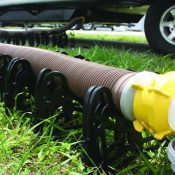
3 Must Haves for All RV’rs
There is always the exception; if dry camping is the only way your RV is used, 1 or 2 of these 3 principles will not apply to you…
A water pressure regulator like this one, is economical and easy to store. Without a regulator the water pressure may spike or remain high-to-dangerously-high anytime the water is hooked up and turned on but not flowing.
Most RV parks do not regulate the water pressure. It is best for the campers that it not be regulated to allow the flow to remain consistent and healthy for 20-200 RV’s (or even more) based on the size and location of the RV park.
One common mistake is to confuse flow with pressure. Flow is really what we are after, unless we’re trying to pressure wash something. Our recommended water pressure regulator from Joppa Creek doesn’t restrict the flow so your shower will feel like you like it to. The standard for maximum water pressure is 80PSI. Some fixtures will accept 100PSI but as an overall the city water system should never exceed 80PSI. 40-50 PSI is all the pressure you’ll need as long as your getting 2-3 (or more) Gallons Per Minute (GPM).
A lot of choke points exist in an RV water system. For example, the water line used from the campground: If they chose to use a small ID pipe it will restrict the amount of water that can run through it. Consider a straw in your milkshake; a bigger straw makes drinking the treat easier. Then there is the valve that your hose hooks to. Is it fully open?
Onward to things we can control a little. Most “inexpensive” potable water hoses are 1/2”. We recommend 5/8”. 1/8” doesn’t sound like much, but it can make more than 1 gallon a minute of flow difference at a nominal 50PSI. When using a water pressure regulator: place it on the water spout and then hook your hose to the regulator. This protects your hose and camper.
Lets pause for some rarely thought or talked about benefits with regulating the water pressure:
Water Heaters work better
More than protection from over-pressurization: water heaters will perform more reliably, toilets will flush better and showers will be more satisfying if a consistent pressure is maintained. 45-55 PSI is the optimal pressure for 3/8 to 1/2 water lines. This is the size of RV water lines. This pressure range allows for the most water volume to flow through the pipes without unneeded stress on the RV’s water system. More pressure doesn’t lend itself to any greater benefit.
Surge Protector: There are 2 types of surge protectors: Active and Passive. The biggest difference is that an active surge protector physically turns off the power and a passive attempts to shunt the surge voltage to ground or dissipate it through “burning” of the conductors or capacitors. For most Recreational Vehicles electrical systems the passive will do. However, with a sophisticated electrical and appliance package you may want to consider an active protector. The active protectors have differing parameters for operation. All of them will turn off the power if the voltage is high. Others will also turn off the power if the voltage gets low or if the frequency gets out of range. Low voltage is just as common and can be more debilitating to your appliances and electronics. Either style can be external (attached at the pedestal) or built-in and connected directly to your power distribution box. Which ever style and fitment you choose, protect yourself and investment. Get and use a surge protector.
Waste water holding tanks. The most preventable repair we get called on is a clogged black tank. There are 2 main reasons and both are fully preventable. The design of the drain system requires more water than expected. Leave your tank closed until it is over half full; the fuller the better.
What we see a lot is the RV is on a sewer site and the black tank is left open to drain. The tanks have a “belly” that will hold the solids and the water then trickles off.
“But I rinse it out!” Yes, I hear that, and I raise you a “that doesn’t work”. When the tank is left closed the liquid and the toilet chemical turn the waste into a sludge that can run out. When draining, this slurry generates a vortex, or vacuum, and will pull itself clean.
If using a portable waste tank be sure the black tank can fully drain in a single dump. (If you have a 30 gallon black tank, you will need a tote tank that exceeds 30 gallons.) If not, it runs the risk of breaking the vortex and allowing the remaining solids to stay in the tank and build a clog.
On the other side of the system we see a good bit of toilets overflowing. Generally this is because not enough water was in the bowl of the toilet when it was flushed down. Most of us are accustomed to household toilets where we push a lever and it does all the work. RV toilets are made to conserve more water, so if we are “dry” camping or without water and sewer hookups the fresh tank will drain and the waste tank will fill too fast.. The RV toilet requires us to fill the bowl manually. Some water will naturally remain in the bowl after a flush and if the use is liquid only then there will be plenty. When solids are flushed the bowl needs to be filled with water before flushing otherwise it will hang in the pipe between the toilet and tank. (Yuck!)
As for the grey tank: (showers and sinks) a little bit of grease from cooking and soap scum will steadily build in the tanks drains and slow (or stop) the drain process. Using grey water treatments will help to eliminate this buildup. The grey water treatments are not needed after every dump like the black water. Since every RV’er will use theirs somewhat differently (how long it is used, how many people, what food is cooked, etc.…) it is best to follow the directions on the bottle.
I hope if you took the time to read this post it helps you. If you have specific questions or ideas you would like to share contact us via email [email protected] or text us or call us. We are here for you!



